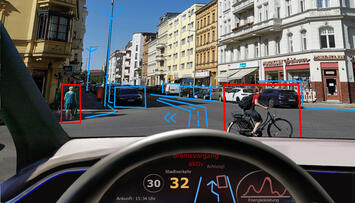
Visionary images of resilient cities that save the US, or even the world, from climate change. Of downtowns transformed by technology into smart ecotopias. Of urban oases that sprout from scratch in the deserts of the Southwest or the Middle East or Mars.
The current cascade of proposals for a green future rooted in our cities—some with practical elements, others pure fantasy—share a myopic take on urbanism. The visions don’t extend far enough to see suburbia as the site of our best option (and undoubtedly the only affordable one) for the conversion of “urban” America from today’s fragmented, polluted, degraded landscape into a renewable environment.
Our development strategy for suburbia in the coming years will be the most fundamental factor in future sustainability. The 2020 census revealed what has long been evident: Last century’s war between the cities and the suburbs is over. The suburbs won. The communities where most new development is taking place are not just suburbs, they’re exurbs, suburbs of the suburbs.
At MIT’s Center for Advanced Urbanism we just completed a two year-plus project which not only confirms the demographic primacy of suburbia, but points to its profound environmental implications. Our research team replaced flawed, 19th century methods with a novel technique, successfully peer reviewed and then tested in Canada and Australia. We looked at neighborhoods for all 350 U.S. Metropolitan Areas—the places where 86% of American households live—using census data, Geographical Information Systems, Google Earth and Google Street View.
Here’s what we found: Most—63%—of those the U.S. Census defines as “urban” Americans are actually suburbanites who commute by car from auto-dependent places. An additional 18% live in exurbia and also commute by car. People that live relatively close to city centers and ride in by public transit are another 13%. Still, even they rely on cars in their home communities.
Any realistic route to a sustainable urban future needs to harness this combined population, a racially and economically diverse 92% of U.S. “metropolitan” residents, and their automobile-based mind-set. It’s these suburbanites in their much-dissed ‘bedroom’ communities and anything-but-iconic houses that can create the radical changes we need.
Transportation is key. The mass adoption of the automobile was the primary catalyst for the design of 20th century suburbs, and our infrastructure was built to support it.
Today, we need a different catalyst. If metropolitan America’s sprouting exurbs and older suburbs are going to be sustainable, then the sea of asphalt and concrete paving built to enable last century’s automobiles has to shrink. And what has to expand—on a colossal level—is the adoption of suburb-friendly, automated electric vehicles (AEVs) and mobility systems and the kinds of pathways they require.
We need to make a much bigger move than the suggestions in current versions of the infrastructure bill, which includes some funding dedicated to electric vehicles, but not nearly enough. Driverless personal or shared cars and automated bus rapid transit, options that can also enable independent travel for the elderly and disabled, are critical. And we should be looking at the advantages of last-mile vehicles like electric bikes and errand robots, which, in addition to other benefits, expand low-cost consumer choices.
The retrofitted roadways for these mobility systems would make ideal cornerstones for the creation of sustainable communities. The transition could allow for a major reduction in road and parking surfaces, which in turn would increase stormwater capture, heat mitigation, carbon sequestration, and biodiversity.
AEVs alone would substantially reduce roadway wear-and-tear and runoff from contaminated petroleum products. And the environmental benefits would soar if our policies included incentives for zoning codes that permitted new land-use mixes. The average U.S. household makes about four car trips a day outside of work-related activities. That car-for-every-errand way of life places an enormous burden on road infrastructure. The dividend would multiply if the remote work trend accelerated or was further solidified by Covid 19.
Ongoing suburban spread away from our central city cores doesn’t have to be an environmental horror story. It’s a rich opportunity to transform not only transport, but all our patterns of energy usage, waste disposal, and infrastructure creation. The sustainable future is right in our own backyards.
Alan M. Berger is Professor of Landscape and Urbanism at M.I.T. and Director Emeritus of the M.I.T. Norman B. Leventhal Center for Advanced Urbanism. David Gordon is Professor and former Director of the School of Urban and Regional Planning at Queen’s University, Ontario, Canada.
Photo credit: Eschenzweig via Wikimedia under CC 4.0 License.












